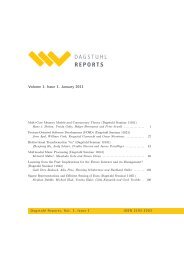Uncertainty modeling and analysis with intervals - DROPS - Schloss ...
Uncertainty modeling and analysis with intervals - DROPS - Schloss ...
Uncertainty modeling and analysis with intervals - DROPS - Schloss ...
You also want an ePaper? Increase the reach of your titles
YUMPU automatically turns print PDFs into web optimized ePapers that Google loves.
44 11371 – <strong>Uncertainty</strong> <strong>modeling</strong> <strong>and</strong> <strong>analysis</strong> <strong>with</strong> <strong>intervals</strong>: . . .<br />
Radström <strong>and</strong> S. Markov but directly the properties of the subset of these polynomials. We<br />
study a little of the geometry of the embedding of <strong>intervals</strong> into a quasi-vector space <strong>and</strong> some<br />
of the properties of the mapping of constrained <strong>intervals</strong> into a space of polynomials.Thus,<br />
there are two parts to this talk. (1) The representation of <strong>intervals</strong> as linear polynomials <strong>with</strong><br />
non-negative slopes. (2) The algebraic structure of this new representation. The geometry is<br />
mentioned in passing as a way to visualized the embedded space <strong>and</strong> will not be discussed<br />
further. The theoretical reason for considering a new representation of <strong>intervals</strong> is to have<br />
a formalization in (a subset of) polynomial space <strong>with</strong> the view to evaluate expressions<br />
(functions) of <strong>intervals</strong>. The theoretical reason for considering the algebraic structure of the<br />
embedding into a space <strong>with</strong> inverses is to solve equations. We only look at additive inverses<br />
in this presentation.<br />
3.17 Verification <strong>and</strong> Validation Requirements in Biomechanical<br />
Modeling <strong>and</strong> Simulation<br />
Wolfram Luther (Universität Duisburg-Essen, DE)<br />
License Creative Commons BY-NC-ND 3.0 Unported license<br />
© Wolfram Luther<br />
Joint work of Luther, Wolfram; Auer, Ekaterina; Chuev, Andrey; Cuypers, Roger; Kiel, Stefan<br />
URL http://www.scg.inf.uni-due.de/fileadmin/Veroeffentlichungen/papereuromech.pdf<br />
We give an overview on how accurate <strong>and</strong> verified methods can be employed for several<br />
biomechanical processes. Our focus is on a broad field of patient specific preoperative<br />
surgical planning based on the superquadric (SQ) geometrical <strong>modeling</strong>. We show how to use<br />
verified tools to efficiently <strong>and</strong> reliably implement important parts of the processing pipeline.<br />
Furthermore, we describe our current activities to verify SQ-based operations numerically<br />
<strong>and</strong> to validate the models <strong>and</strong> their parameters by various measurement methods. For this<br />
purpose, we replace or combine data types, algorithms <strong>and</strong> tools <strong>with</strong> their verified versions<br />
where possible. Here, we might consider using C-XSC (Krämer) instead of plain C++,<br />
INTLAB (Rump) in addition to Matlab, DSI (Dempster Shafer tool <strong>with</strong> <strong>intervals</strong>) instead<br />
of IPP (the Imprecise Probabilities toolbox, Limbourg, Rebner) or employing stochastic data<br />
types as in Cadna++ (Lamotte et al.) or the static program analyzer Fluctuat (CEA).<br />
Recently, we introduced four classes for the use in V&V assessment, from lowest to<br />
highest certification st<strong>and</strong>ard. A process implementation that relies on st<strong>and</strong>ard floatingpoint<br />
or fixed-point arithmetic <strong>with</strong> unverified results belongs to Class 4. If the system is to<br />
qualify for Class 3, the numerical implementation of the process needs to employ at least<br />
st<strong>and</strong>ardized IEEE 754-2008 floating-point arithmetic. Furthermore, sensitivity <strong>analysis</strong><br />
has to be carried out for uncertain parameters <strong>and</strong> uncertainty propagated throughout the<br />
subsystems using various methods. Additionally, a priori/posteriori error bounds should<br />
be provided for important sub-processes, condition numbers computed, failure conditions<br />
identified. To belong to Class 2, relevant subsystems have to be implemented using tools<br />
<strong>with</strong> result verification or <strong>with</strong> an accompanying computation of reliable error bounds. The<br />
tools should use language extensions, the convergence of numerical algorithms must be<br />
proved via existence theorems, analytical solutions, computer-aided proofs or fixed-point<br />
theorems. In Class 1, uncertainty is quantified <strong>and</strong> propagated throughout the process using<br />
interval computing. Model parameters are optimized by calibration. The whole system is<br />
verified using tools <strong>with</strong> result verification. Basic numeric algorithms <strong>and</strong> (special) functions<br />
are certified. Alternatively, real number algorithms, analytical solutions or computer-aided













